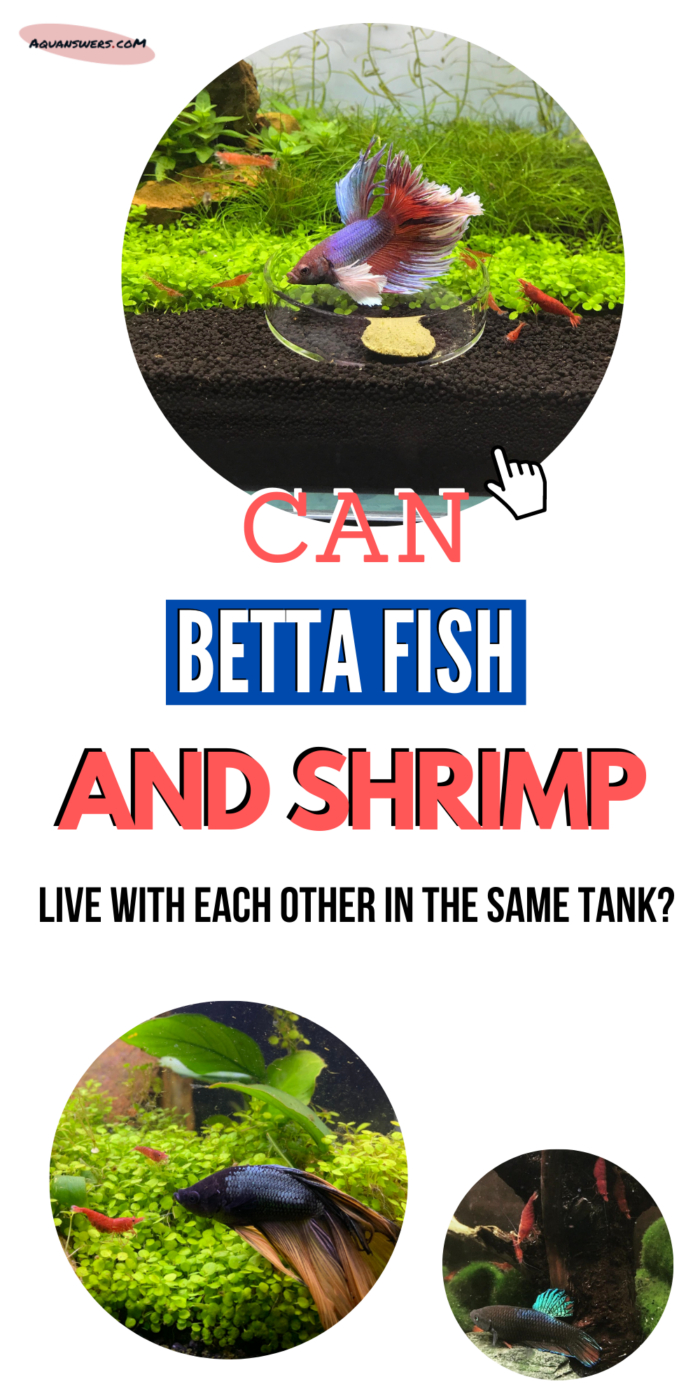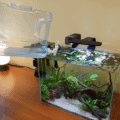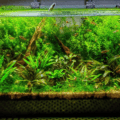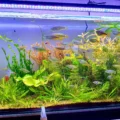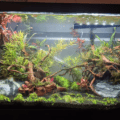Spicing up your new aquarium with some exotic freshwater crustaceans is always a good idea.

People have always asked me if Betta fish and shrimp can live together peacefully.
It seems reasonable to think that the Betta would attack the shrimp because it eats meat.
However, many hobbyists report that some shrimp species, such as the Ghost, Cherry, and Amano Shrimp make good tank mates for their Betta fish.
Typically, success is strongly dependent on the character traits of your Betta and whether it’s aggressive or not.
Why is that and what else makes it possible for shrimp to harmoniously coexist with a Betta in the same tank?
Can Betta fish and shrimp live together in the same aquarium?
The Betta fish is a carnivore which means that it will not miss the chance of eating any small insects that would boldly cross its path. The digestive system of Betta fish has evolved to extract and process nutrients from the chitin exoskeletons of small crustaceans and insects.
This could affect a Betta’s relationship with freshwater shrimp, because it may potentially see the crustaceans as a quick meal when hungry. That, being said, here is if Betta fish and shrimp can live together in the same aquarium:
The individual personality of your Betta plays a key role in its compatibility with shrimp. It’s likely that a non-aggressive Betta fish and some agile shrimp species would manage to peacefully live together in the same tank. Keeping the Betta fed, and providing artificial hideouts or dense aquatic plants, for the shrimp, improves the chances of peaceful coexistence.
It may also help if the aquarium is big enough to provide both species with more personal space.
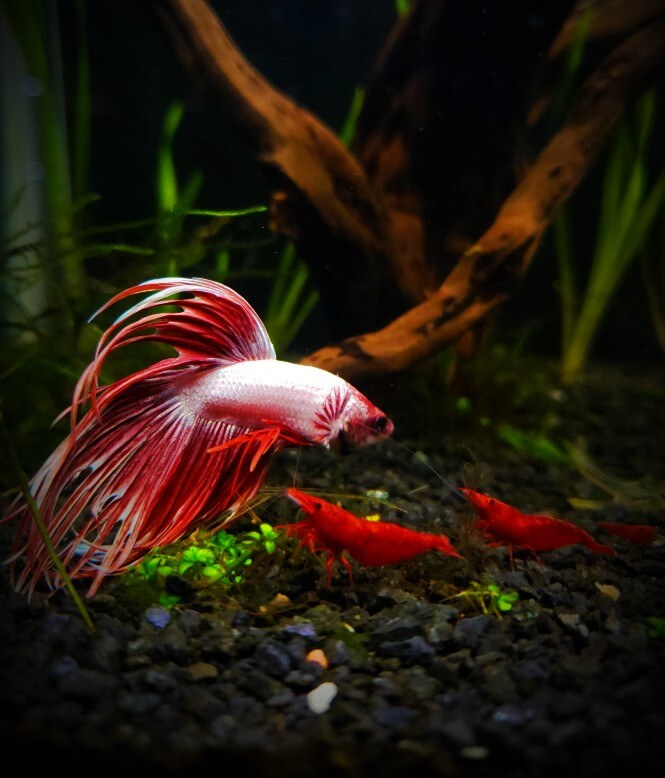
By zbrnwsk
Some Betta fish have no problem sharing their tank with almost any other fish or shrimp.
On the other hand, there are the hot-tempered ones who won’t let anything in their territory and will attack every intruder who dares to enter their kingdom.
How would different shrimp species work in a Betta tank?
Take a look at the most common shrimp species that may be kept with a Betta fish:
1. Bettas and Ghost Shrimp
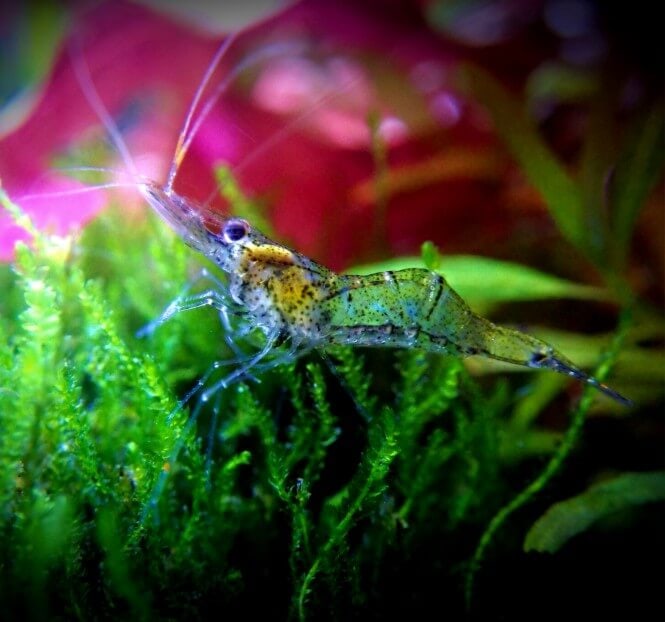
By ironbamboo
In the majority of cases, Betta fish and Ghost shrimp are compatible and may live together with no conflicts.
The Ghost shrimp will mind their own business at the bottom of the aquarium and won’t be interested in the rest of the tank mates.
The almost transparent coloration of these shrimp won’t attract your Betta’s sight, so they won’t be perceived as an intruder. Ghost shrimp are also large enough to not get eaten by your Betta since they reach a size of about 1.5 inches when mature.
However, if your individual fish is really aggressive in nature, it might still try to attack the shrimp.
For this reason, there are a few things to have in mind when mixing Betta fish and Ghost shrimp in the same tank.
If you’d like to breed this shrimp, I would recommend that you use a separate aquarium for the purpose. You could transport any pregnant Ghost shrimp there as soon as you notice them carrying eggs.
A Betta will probably eat all the Ghost shrimp babies it comes across.
Anyway, the shared aquarium should also have enough plants in order to prevent any potential conflicts.
A 10-gallon planted tank could sustain a small colony of Ghost shrimp while giving them enough space to hide from the Betta when needed.
Author’s note: Do make sure that you’re getting Palaemonetes Paludosus when shopping for Ghost shrimp though.
Sometimes pet stores may mistakenly sell a larger, more aggressive Ghost shrimp species called Macrobrachium Lanchesteri.
Macrobrachium Ghost shrimp can actually turn the tables and start picking on the long fins of your Betta, which could lead to some serious damage for the fish.
The easiest way to spot the difference between the two species of Ghost shrimp is to take a look at their front claws.
Macrobrachium Lanchesteri has visibly longer front claws, in comparison to the ones of a Palaemonetes Paludosus.

2. Bettas and Cherry shrimp

By Odin343
The Cherry shrimp are a beautiful and noticeable species of freshwater shrimp, that reach a size of 1 to 1.5 inches when fully grown.
If you want your Cherry shrimp to live with a Betta in the same aquarium, I recommend that you put both species in the tank simultaneously.
If that is not an option and your Betta is already the royalty of its tank, you should temporarily relocate it to another container.
After that, rearrange the decoration in your main aquarium, put the Cherry shrimp in, and bring back the Betta.
This way, you’ll likely reduce the chance of the Betta attacking the shrimp since it won’t perceive them as intruders in its personal space.
The Betta won’t recognize its old tank, perceiving it as a completely new place.
Needless to say, there isn’t a 100% guarantee that your Betta won’t try to eat or attack the Cherry shrimp.
If you see any early signs of an annoyed fish, such as flaring at or chasing the Cherry shrimp, separate them. Note that the Cherry shrimp are quicker and more agile than Ghost shrimp and stand a better chance of evading the attack of a more aggressive Betta.
The slightly higher price of Cherry shrimp is the only reason they are not my top recommendation for shrimp that can live with a Betta.
In terms of survival, however, I think that the Cherry shrimp stands the best chance from the smaller shrimp species that are commonly sold in pet stores.
AQUAnswers TIP If you enjoy having brightly colored aquarium creatures, try the Blue Velvet shrimp, which is a variation of the Cherry shrimp.This variety has a beautiful and intense blue coloration, which is also less likely to stand out in your Betta’s eyes if the fish tank is decently planted.
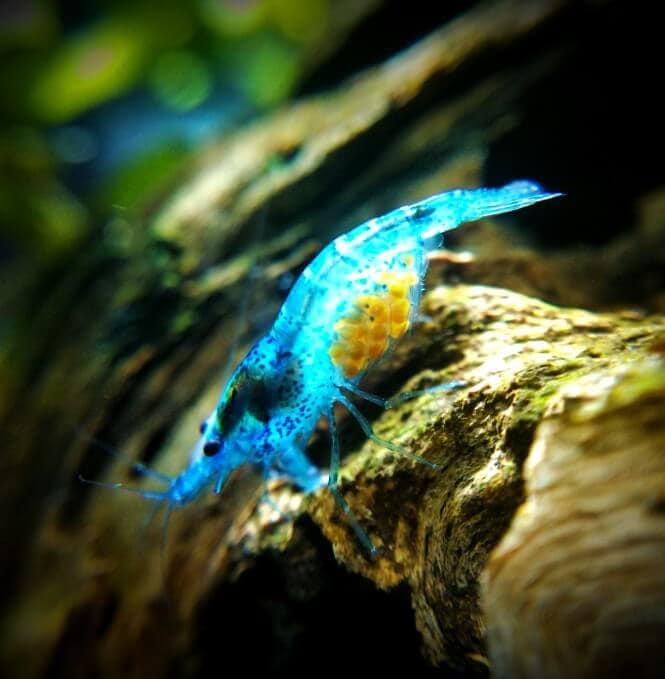
By Ohaple
3. Bettas and Amano Shrimp
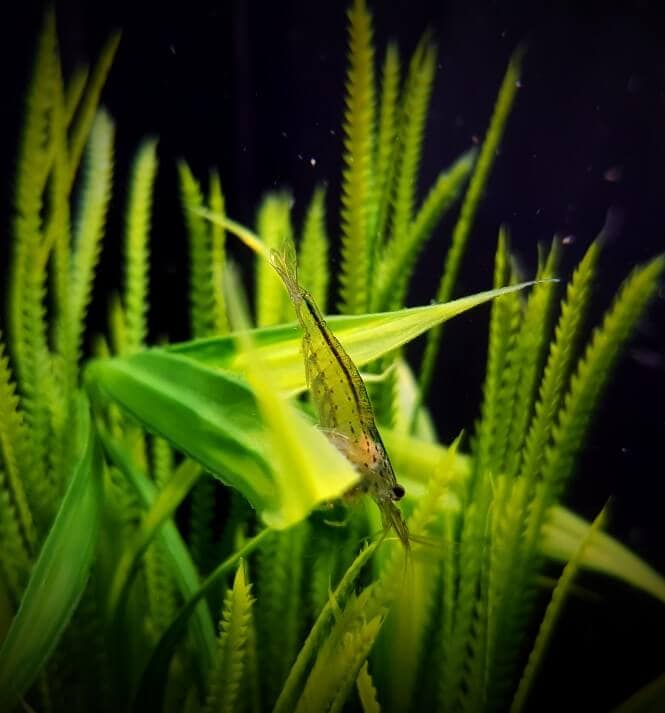
By ml-photo
These small creatures are often nominated as one of the best shrimp to keep with a Betta or other fish.
My personal experience with these shrimp confirms that opinion.
Amano shrimp are peaceful and are very helpful with cleaning the algae in a fish tank. If you want to try keeping them with your Betta fish, put enough live plants and driftwood decorations to avoid potential aggression.
The aquarium decor will serve as hideouts for both the Betta and the shrimp.
The tank you use should hold 10 or more gallons of water, as the Amano shrimp are larger compared to other aquarium shrimp, such as the Ghost ones.
An important thing to remember here is that Amano shrimp and Betta fish have different dietary needs.
Betta fish are carnivores and will need some freeze-dried bloodworms, Daphnia, and, possibly, live insects.
The Amano shrimp will eat algae directly from the aquarium’s interior but you should still supplement their diet with some algae wafers, dried pellets, or zucchini.
Sometimes, when the Amano shrimp see new food falling on the tank’s bottom, they get somewhat dominant and try to get their meal first.
This may stress out your Betta and provoke the fish to defend its food.
Considering that the average size of mature Amano shrimp is 2 inches and upwards, no Betta will be able to eat them.
They are also more agile than Ghost shrimp but you should still observe the aquarium for any chasing, nipping, and possible injuries.
4. Bamboo Shrimp and Bettas
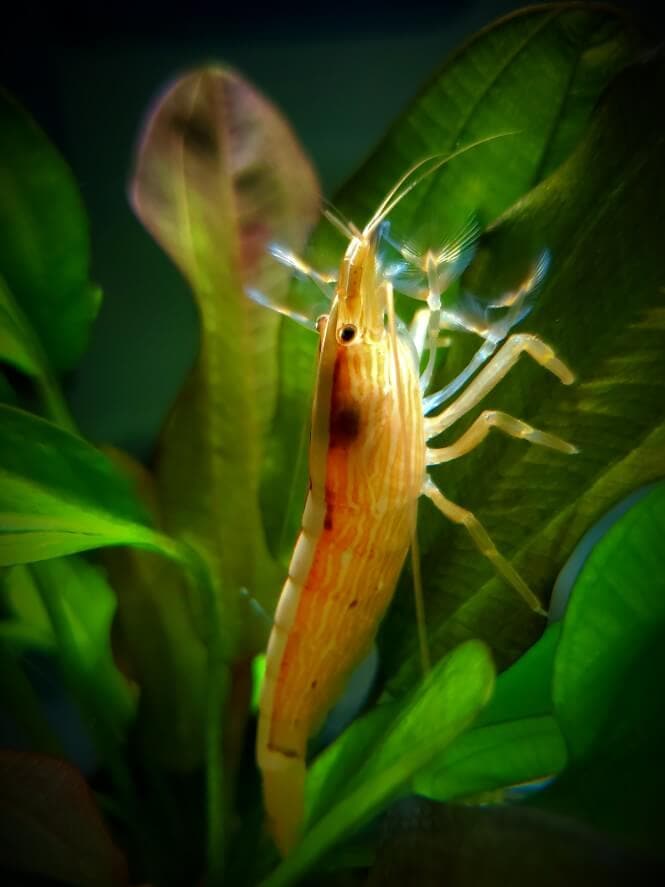
By ThisPeachIsSubpar
Unlike most aquarium shrimp, the Bamboo shrimp may swim through the water column in search of food.
If you want to have Bamboo shrimp in your aquarium, the water filter should provide a decent amount of current.
Also, apart from the live plants, Bamboo shrimp like the presence of stones or rocks in their tank.
Those will be used as a ladder to provide the shrimp with access to the filter’s current.
A larger tank is one of the most important conditions when it comes to keeping Bamboo shrimp and a Betta fish together.
Bamboo shrimp reach up to 3.5 inches when fully grown and remain very active throughout their life.
They can easily catch the attention of your Betta.
Also, the Bamboo shrimp prefer waters with a moderate-to-strong flow, unlike a Betta. The large fins of the Betta could make swimming in a current really exhausting for the fish.
A 20-gallon “Long” aquarium has dimensions of 30.25 x 12.5 x 12.75 inches and thus provides enough horizontal space for both species to live in peace without bumping into each other too often. Make sure the fish tank is heavily planted while having areas that are not affected by the filter’s flow.
These areas will act as hideouts for your Betta.
5. Crystal shrimp and Bettas
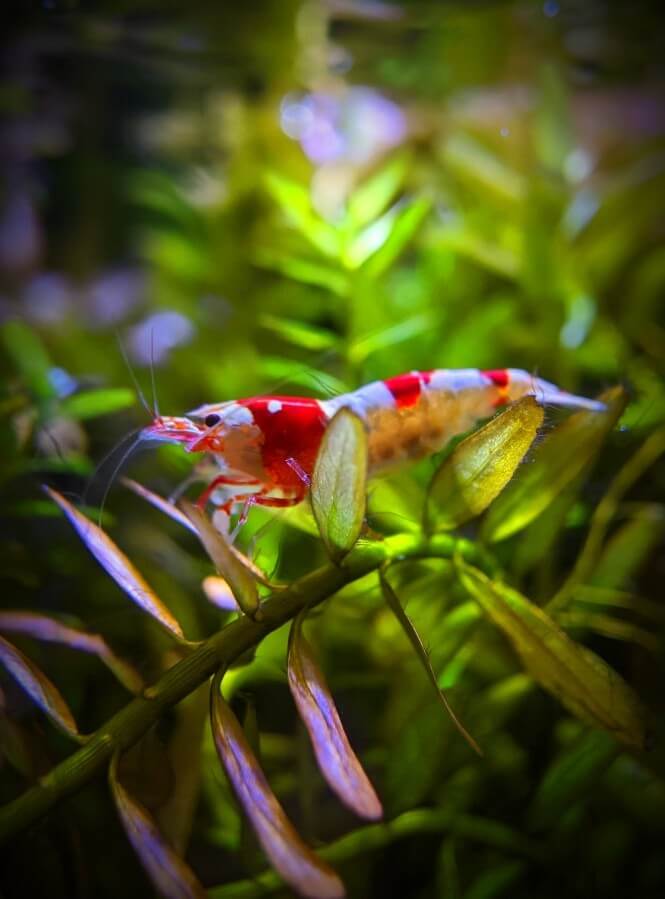
By belleri7
The beautiful Crystal Red Shrimp could be a colorful addition to a peaceful community aquarium. Unfortunately, my experience shows that the Crystal Red shrimp are the least suitable match for a Betta fish.
Not only does their bright red and white coloration draw attention, but they are also a dwarf shrimp species, reaching only about 1.25 inches in body length.
The Crystal Red shrimp will inevitably end up as a favorite snack of the Betta and the two species can’t really live together in peace.
From what I’ve observed, the coexistence lasted no more than a few days and it did not matter what tank size I had them in, or whether or not my Betta was well-fed.
If you really want to try and make it work, planting a lot of live plants in the tank would be a good start.
Feed your Betta regularly, and, fingers crossed, you won’t end up overpaying for live food treats.
6. Bettas and Vampire Shrimp
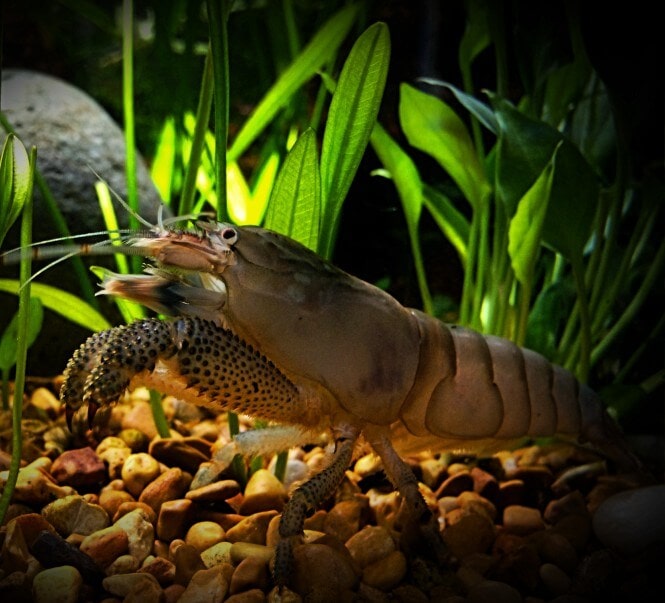
By beingevolved
Also called the Giant African shrimp, the Vampire shrimp is quite interesting to observe.
Peaceful and nocturnal by nature, Vampire shrimp need lots of live plants to explore.
They are filter feeders, which means that they will catch small food particles in the water column of the aquarium.
Vampire shrimp can tolerate a wide variety of water conditions, which makes them a great tank mate for peaceful fish species.
However, with their average mature size of 4 inches that comes with a thicker body, they will likely draw the attention of a Betta fish.
The Vampire shrimp are large enough to not get eaten by the Betta and are also extremely timid.
If your Betta comes off as more aggressive, the Vampire shrimp will likely stay hidden most of the time.
What’s more important to consider if you want these two to live together in harmony is the tank’s size and its aquascape.
Same as the Bamboo shrimp, Vampire shrimp are filter feeders and thus prefer a stronger water current in their tanks.
To successfully keep Betta fish and Vampire shrimp together you’ll need a 20-gallon Long aquarium that has low and high flow areas.
Use aquatic plants, driftwood, and artificial decorations to block the water flow in certain spots where your Betta could retreat when exhausted.
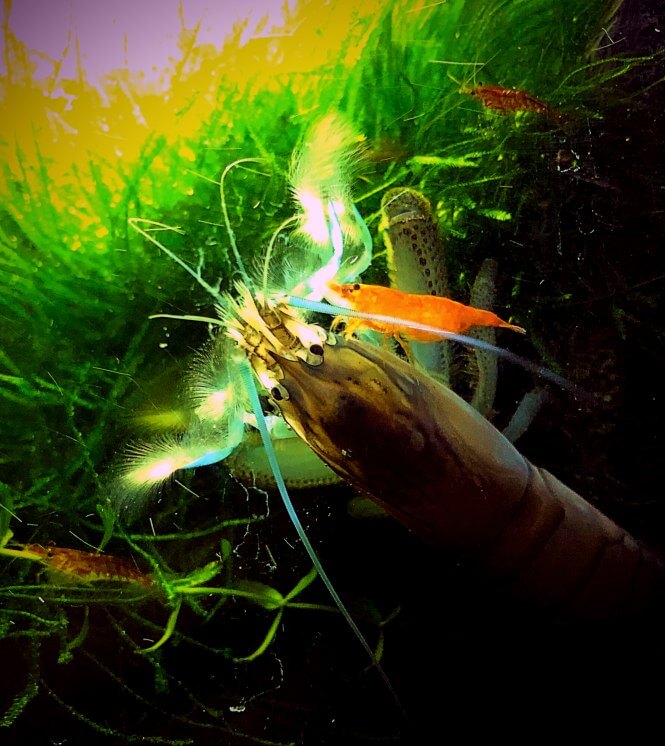
By Taggyz
7. Bettas and Blue Bee Shrimp
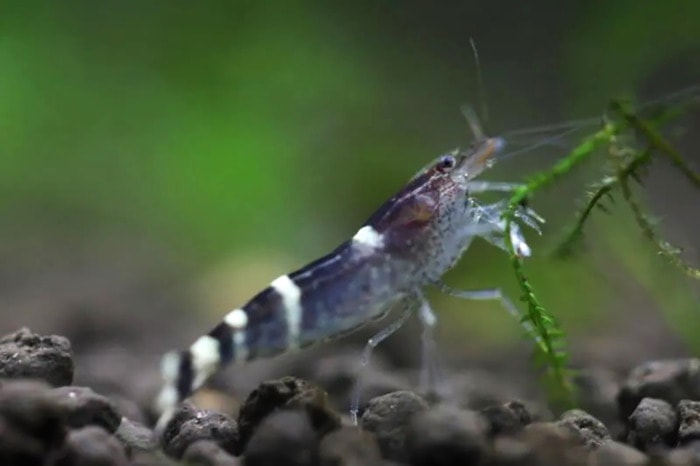
By gabeszone247
Blue Bee Shrimp are a rather uncommon shrimp species in the aquarium trade.
Most if not all of the specimens that can be found are wild-caught, with only a handful being bred by hobbyists.
And even though they share the same moniker as some Caridina species, these shrimp actually belong to the Paracaridina genus.
However, they’re yet to be ascribed a species since there isn’t enough scientific data about them.
Since Blue Bee Shrimp have vivid coloration and typically grow to 1.5 inches, bettas might attack them if they’re not introduced to the tank simultaneously.
Therefore, you can apply the same logic as with cherry shrimp when keeping them with betta fish.
Another thing that will increase the likelihood of their survival is furnishing their tank with abundant vegetation.
This will provide them with plenty of hiding spots in case your betta decides to turn on them.
In the wild, blue bee shrimp inhabit fast flowing, mountain streams that are rich in oxygen.
And even though it isn’t completely necessary, they will appreciate having an airstone in their tank.
Author’s note: Despite their name, blue bee shrimp can be found in a variety of colors including black, brown and even red. All of these color morphs have four white stripes across the abdomen.
Even though these shrimp don’t require much space, I’d suggest you place them in a 10 gallon tank so they don’t get blindsided by your betta.
There are some precautions to take before you place a Betta fish and crustaceans such as shrimp together.
Follow these steps to make the shrimp and Betta combination work:
- Add plenty of live plants and other decor.

By thebettaguy1
All Betta fish love having plants and decorations in their tank.
It’s quite entertaining to watch them swim around those with curiosity.
Also, Betta fish need some personal space at times.
Surprisingly or not, the same applies to freshwater shrimp.
Shrimp actually need to hide from time to time, because they have a natural instinct to do so when they molt and change their exoskeleton. Dense aquatic plants are the perfect hiding spot for shrimp in the case of a Betta attack.
The two species would not be able to live together if there are not enough hiding places, as the shrimp are extremely vulnerable after molting.
This applies to any crustacean from the dwarf Crystal Red shrimp to the bulky, 5-inch-long Vampire shrimp. For me, it makes sense to also add driftwood, artificial caves, and some rocks.
Java Ferns are ideal as beginner-friendly live plants that basically look after themselves. The Moneywort, Amazon Frogbit, and Water Wisteria are just a few of the floating freshwater plants that could make for a beautiful underwater jungle in an aquarium with shrimp and a Betta.
A tall Dwarf Hairgrass carpet can also prove enough of a shelter for the smaller dwarf shrimp.
- Keep your Betta well fed.

By Austin913
If you ask any Betta, there’s no such thing as “enough” food.
But if you want your Siamese Fighter Fish to not see its shrimp tank mates as a potential snack, don’t forget to feed it enough and on time.
Give your Betta its portion of tasty food every day, but be mindful to not overfeed it. Overfeeding may lead to bloating issues for the fish and it may also cause green or cloudy water in the aquarium.
Giving your Betta the right portion of food at the right time, however, will keep its belly full enough to suppress its killer instincts when it comes across shrimp. Ghost, Cherry, and Crystal Red shrimp may get eaten anyway if they are too slow to react or too bold.
Also, feed the Betta something that’s high in exoskeleton fiber to further suppress its appetite for crustaceans. Freeze-dried Daphnia and Mysis shrimp are among the best fiber-rich foods you could get for a Betta fish.
- Choose a big enough tank.

By nntnam
A betta fish can live perfectly fine in a 5-gallon tank on its own. Strictly speaking, Ghost, Cherry, and Crystal Red shrimp will do very well in a 5-gallon tank by themselves too.
However, even though I’ve listed the Betta as one of the best fish to look after in a 5-gallon tank, its potential cohabitation with shrimp sometimes demands a more spacious aquarium.
Though it’s possible to house agile shrimp and a more docile betta in a 5-gallon aquarium, I recommend that you try getting a tank that’s at least 10 gallons. That’s if you want to make absolutely sure the two species will peacefully live together in the same place.
This way you’re making sure the fish and the shrimp have enough personal space to explore without coming across each other too often.
The bigger the fish tank, the less likely it is for the Betta to attack the small crustaceans.
Even having a female Betta (less aggressive than males) is not a guarantee against hostility in smaller tanks with shrimp.
Still, rapidly breeding species such as the Cherry shrimp and (sometimes) the Ghost shrimp can establish a self-sustaining colony in large enough tanks, despite having a more aggressive Betta in the same space.
- Make sure the water parameters are stable at all times.

By obri3
Both Betta fish and shrimp need to live in a fully-cycled aquarium with the right temperature and pH to be happy and healthy.
Before you add any shrimp to your tank, do some research on what water parameters they would need to thrive.
For example, the Cherry shrimp has very similar needs to a Betta when it comes to water conditions – they both prefer to live in aquariums with a water temperature of between 72 and 81°F (22 to 28°C).
The best pH level for the Betta is the neutral one – between 6.5 and 7.5 – which is also suitable for most shrimp species.
Note that freshwater shrimp are very sensitive to Nitrate levels in the water, so make sure you keep those at no more than 10 to 15 PPM. Don’t forget that the best way to estimate the water’s parameters in your aquarium is with a freshwater Master Test Kit because test strips are usually inaccurate.
- Get the right type of filter.
A small sponge filter would be ideal for scavenger dwarf shrimp such as the Cherry shrimp, the Amano shrimp, the Ghost shrimp, and the Crystal Red shrimp. Both the scavenger shrimp and the Betta would prefer the lack of flow a sponge filter provides while benefiting from the biological filtration and water oxygenation.If you’re after the bulkier, filter-feeding shrimp such as the Bamboo and Vampire shrimp, then you’d need to get a filter with a stronger current that could be dissipated and regulated if needed. In that case, canister filters make sense for a 20-gallon or a larger tank as they usually have a spray-bar outlet that can be directed, and an adjustable flow rate valve.
How many shrimp to put in with a non-aggressive Betta?
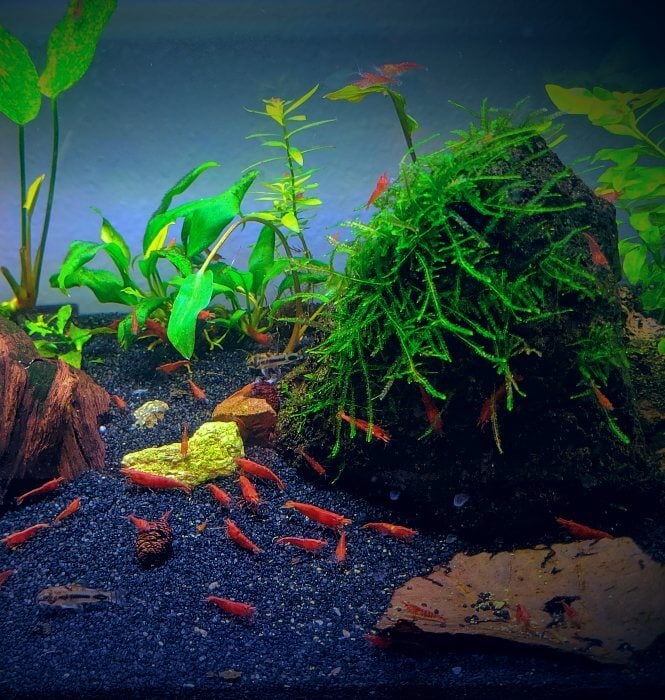
By hWatchMod
The dimensions of your aquarium will be the determining factor when deciding on the number of shrimp that could live with your Betta.
That being said, here is how many shrimp I’d recommend putting inside a tank with a Betta:
- In a 5-gallon tank:
- Four Ghost shrimp;
- Two Amano shrimp;
- Four Cherry shrimp;
- Six Crystal shrimp;
- Bamboo shrimp – It’s not a good idea to keep Bamboo shrimp in a 5-gallon tank, because of their size and food requirements;
- Vampire shrimp: not suitable for a 5-gallon tank, they need at least 20 gallons of water volume.
- And in a 10-gallon tank:
- No Vampire shrimp;
- Eight Ghost shrimp;
- Five Amano shrimp;
- Eight Cherry shrimp;
- One Bamboo shrimp;
- Twelve to fifteen Crystal shrimp.
- Number of shrimp for a 20-gallon Betta tank:
- One Vampire shrimp;
- Twenty Ghost shrimp;
- Eight Amano shrimp;
- Twenty Cherry shrimp;
- Two Bamboo shrimp;
- Up to thirty Crystal shrimp;
Those are approximate numbers, based on my own experience and research.
Of course, you can add less or more shrimp, but take into consideration the bioload, temperament, and needs of both parties in relation to the tank’s gallon capacity.
Related: Starter Tank Kits for Betta Fish
I prefer to leave more space for both species to avoid potential conflicts between them and to make sure all of the tank inhabitants have their favorite spots to themselves.
However, you can safely double the numbers of the smaller shrimp species I listed above.
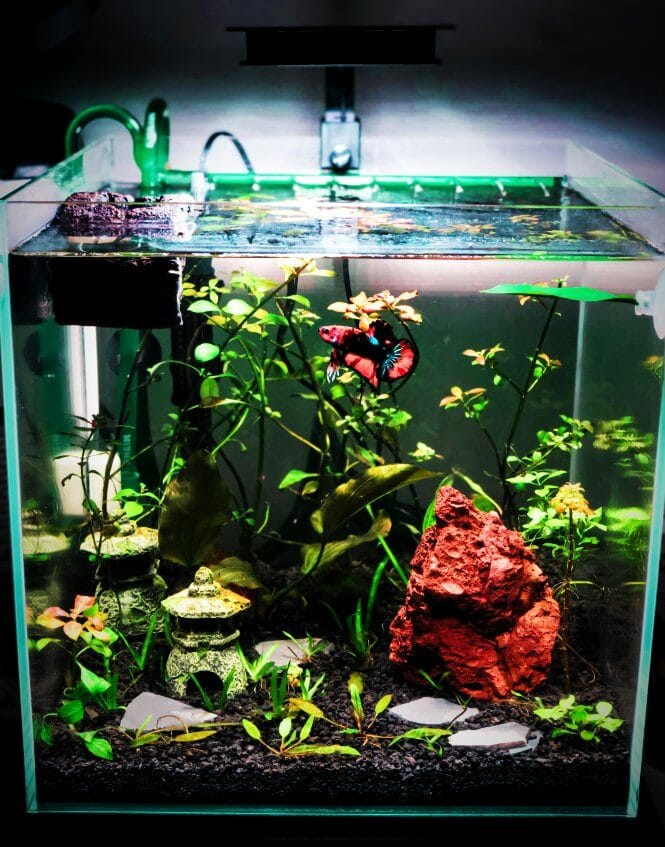
By vacationday
My Personal Advice
Choosing the right companion shrimp to live with your Betta takes just a little bit of research, preparation, and knowledge about the personality of your pet fish.
Whatever shrimp species you choose, make sure the water parameters are stable and that there is enough food and space for all of them.
Feel free to leave me a comment below if you want to share your experience or ask something else about this setup.
